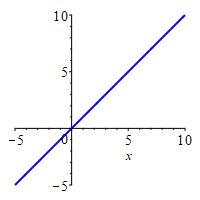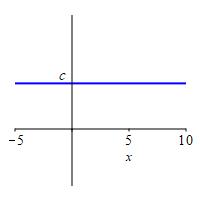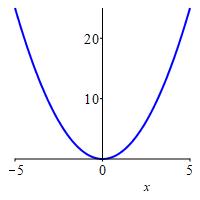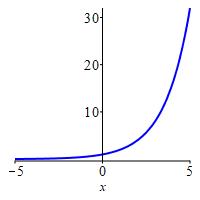7. Computing Limits
a. Limits at Finite Numbers
Now that we understand the intuitive notion of a limit, we are ready to learn how to actually compute limits. Our computations will be justified based on the intuitive definition. The formal proofs will appear in the chapter on Precise Limits and Continuity.
1. Special Limits
Before discussing the computation of limits in general, we first consider some Special Limits.
The simplest two types of functions are the identity function, \(f(x)=x\), and the constant functions, \(f(x)=c\) for any number \(c\). Their plots are:


Their limits are given by:
\[ (1) \qquad \lim_{x\to a}x= a \]
As \(x\) approaches \(a\), we conclude \(x\) approaches \(a\).
As examples we have: \[ \lim\limits_{x\to 3}x=3 \qquad\qquad \lim\limits_{\theta\to \pi}\theta=\pi \]
For any number \(c\): \[ (2) \qquad \lim_{x\to a}c=c \]
For all \(x\), \(f(x)=c\). So as \(x\) approaches \(a\), the value of \(f(x)\) continues to be \(c\).
As examples we have: \[ \lim\limits_{x\to 3}2=2 \qquad\qquad \lim\limits_{x\to e}\pi=\pi \]
The next two groups of functions are the power functions, \(f(x)=x^p\), (with a constant power, \(p\)) and the exponential functions, \(f(x)=b^x\), (with a constant base, \(b\)).
For any number \(p\) and any \(a\gt0\): \[ \lim_{x\to a}x^p= a^p \]
As \(x\) approaches \(a\), the value of \(x^p\) approaches \(a^p\).
As examples we have: \[\begin{array}{ll} \lim\limits_{x\to 3}x^2=9 \qquad & \lim\limits_{x\to 9}x^{1/2} =\lim\limits_{x\to 9}\sqrt{x}=3 \\ \lim\limits_{x\to 3}x^{-2} =\lim\limits_{x\to 3}\dfrac{1}{x^2}=\dfrac{1}{9} \qquad & \lim\limits_{x\to 9}x^{-1/2} =\lim\limits_{x\to 9}\dfrac{1}{x^{1/2}}=\dfrac{1}{3} \\ \end{array}\]
If \(b>0\), then \[ \lim_{x\to a}b^x=b^a \]
As \(x\) approaches \(a\), the value of \(b^x\) approaches \(b^a\).
As examples we have: \[\begin{array}{ll} \lim\limits_{x\to 3}2^x= 8 \qquad &\lim\limits_{x\to 3}\left(\dfrac{1}{2}\right)^x =\lim\limits_{x\to 3}\dfrac{1}{2^x}=\dfrac{1}{8} \end{array}\]
Notice that the Exponential Law does not discuss the case \(b \lt 0\). That is because taking a limit of an exponential with a negative base does not make sense. As \(x\) approaches \(a\), it goes through real numbers for which \((-1)^x\) is undefined, such as \(x=\dfrac{1}{2}\) or any rational number with an even denominator.
Study the difference between the power and the exponential functions. The first is the limit of the variable base \(x\) to a fixed power \(p\). The second is the limit of a fixed base \(b\) to the variable power \(x\). Here are example plots:


Heading
Placeholder text: Lorem ipsum Lorem ipsum Lorem ipsum Lorem ipsum Lorem ipsum Lorem ipsum Lorem ipsum Lorem ipsum Lorem ipsum Lorem ipsum Lorem ipsum Lorem ipsum Lorem ipsum Lorem ipsum Lorem ipsum Lorem ipsum Lorem ipsum Lorem ipsum Lorem ipsum Lorem ipsum Lorem ipsum Lorem ipsum Lorem ipsum Lorem ipsum Lorem ipsum